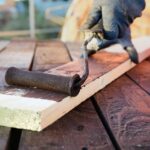When it comes to owning a home, keeping track of receipts, warranties, and maintenance records may not be the most exciting task, but it is crucial for homeowners. In this article, we will discuss how long to keep home improvement records to ensure you are prepared for any future renovations or repairs.
Home improvement records serve as a valuable resource for homeowners, providing documentation of past projects, expenses, and warranties. By maintaining these records, homeowners can easily reference previous work done on the property, track expenses for tax purposes, and ensure warranties are honored in case of any issues. Whether it’s a minor repair or a major renovation, having accurate and organized home improvement records can save time and money in the long run.
From receipts for materials and labor costs to warranties for appliances or installations, there are various types of home improvement records that should be kept. In the following sections, we will explore the importance of different types of records, discuss effective ways to organize and store them, and provide insights on when it may be time to declutter old records.
So let’s delve into the world of home improvement records and learn how they play a vital role in maintaining your property.
Types of Home Improvement Records to Keep
Keeping detailed records of your home improvement projects is crucial for various reasons. It not only helps you track your expenses and budget but also comes in handy when it’s time to sell your property or make insurance claims. When determining how long to keep home improvement records, it’s essential to understand the types of documents you should retain.
First and foremost, receipts for all purchases related to your home improvements should be kept for a significant period. This includes receipts for materials, tools, equipment, and any hired services. These receipts serve as proof of expenses incurred during the project and may be necessary for tax purposes or in case of warranty claims down the line.
Additionally, contracts with contractors or service providers should be retained for an extended period after the completion of the project. These contracts outline the scope of work, timelines, costs, and warranties provided by the contractor. Having these documents on hand can help resolve any disputes that may arise in the future regarding the quality of work or adherence to agreed-upon terms.
Another important type of record to keep is permits and inspection reports from local authorities. These documents demonstrate that the work done on your property complies with building codes and regulations. They are crucial when proving the legality of alterations or additions made to your home during resale or refinancing processes.
| Document Type | Recommended Duration |
|---|---|
| Receipts for purchases | 3-7 years |
| Contracts with contractors | 10 years |
| Permits and inspection reports | As long as you own the property |
Organizing and Storing Home Improvement Records Effectively
When it comes to managing your home improvement projects, keeping detailed records is crucial. Not only does it help you stay organized, but it also serves as a valuable resource for future reference. One of the key aspects of maintaining these records is organizing and storing them effectively. The question often arises: how long should you keep receipts for home improvement projects?
To start with, it is recommended to keep all receipts related to home improvement projects for at least three to seven years. This time frame allows you to have documentation in case any issues arise or if you decide to sell your property in the future. By holding onto these receipts, you can prove the costs incurred, demonstrate compliance with building codes, and validate any warranties or guarantees associated with the work done.
In addition to receipts, other essential home improvement documents to keep include contracts, permits, invoices, and before-and-after photos of the projects. Organizing these records in a dedicated file cabinet or digital folder can make it easier to access them when needed. Remember that proper organization not only saves time but also ensures that important information is readily available for insurance claims or resale purposes.
How Long Should You Keep Receipts for Home Improvement Projects?
When it comes to home improvement projects, keeping receipts is crucial for various reasons. Not only do they serve as proof of purchase and ownership, but they can also be important for insurance claims or potential repairs in the future. However, knowing how long to keep these receipts can be a common question among homeowners. Here are some guidelines on how long you should hold onto receipts for home improvement projects:
- Store Receipts for Warranty Purposes: It’s recommended to keep receipts for any home improvement projects that come with warranties or guarantees for the duration of the warranty period. This allows you to easily reference and prove your purchase in case you need to make a claim.
- Keep Receipts for Tax Purposes: If the home improvement project is eligible for tax deductions or credits, it’s important to retain receipts for at least three to seven years, depending on your country’s tax laws. This ensures that you have documentation to support your claims if audited by tax authorities.
- Retain Receipts for Resale Value: If you plan on selling your property in the future, keeping receipts from home improvements can increase the resale value of your home. Prospective buyers often look for evidence of quality upgrades and renovations, so holding onto receipts can help justify a higher asking price.
In addition to these guidelines, it’s always wise to consult with a financial advisor or tax professional regarding specific regulations around record-keeping for home improvements. By staying organized and mindful of how long to keep home improvement records, you can protect yourself financially and ensure a smoother process in case of any unexpected issues down the line.
Importance of Keeping Warranties and Guarantees for Home Improvements
When it comes to home improvements, keeping warranties and guarantees is essential for ensuring peace of mind and protecting your investment. Warranties and guarantees can provide you with recourse in case something goes wrong with the materials or labor used in your home improvement projects. They serve as a form of insurance against unforeseen issues that may arise after the work is completed.
One common question that homeowners often ask is: “how long to keep home improvement records?” The answer varies depending on the type of warranty or guarantee you have. In general, it is advisable to keep all warranties and guarantees for as long as they are valid. Some warranties may last only a few years, while others can span decades. It’s important to carefully review each document to understand the coverage period and any conditions for maintaining the warranty.
| Warranty Type | Duration |
|---|---|
| Manufacturer’s Warranty on Appliances | 1-5 years |
| Roofing Material Warranty | 15-30 years |
Keeping Track of Maintenance and Repair Records
When it comes to home improvement projects, keeping track of maintenance and repair records is crucial for homeowners. These records provide valuable information about the history of your home’s maintenance tasks, repairs, and upgrades. By having these records on hand, you can easily reference past work done on your property, stay on top of routine maintenance schedules, and even increase the resale value of your home.
To effectively track maintenance and repair records, consider using the following strategies:
- Create a designated filing system: Organize all paperwork related to maintenance and repairs in a dedicated filing system. Utilize folders or binders to categorize documents by type (e.g. receipts, warranties) or by area of the house (e.g. kitchen renovations, HVAC repairs).
- Use spreadsheets or digital tools: For a more efficient way to track maintenance tasks and repairs, consider creating a spreadsheet or using digital tools like apps or software. This allows you to easily input data, set reminders for ongoing maintenance tasks, and quickly search for specific information when needed.
- Implement a logbook: Keep a detailed logbook where you document all maintenance and repair work done on your property. Include dates of service, descriptions of work performed, invoices/receipts attached, contact information for service providers, as well as any warranties or guarantees associated with the work.
By implementing these strategies for tracking maintenance and repair records, homeowners can ensure they have all necessary documentation readily available whenever needed. Whether it’s for personal reference during future home improvement projects or for potential resale purposes down the line, maintaining organized records of maintenance and repairs is key to responsible homeownership.
Cleaning and Decluttering Old Home Improvement Records
When to Clean and Declutter
Over time, our homes accumulate a lot of paperwork related to past home improvement projects. It is essential to periodically review these records to declutter and organize them effectively. A good rule of thumb is to clean out old home improvement records at least once a year. This will help you stay organized, find important documents quickly, and make space for new records.
Sorting Through Old Records
Start by sorting through your old home improvement records and deciding which ones are still relevant and necessary to keep. Consider whether you still own the property, if the warranty or guarantee is still in effect, or if you may need the information for future reference. Documents like permits, inspection reports, contractor agreements, and receipts for major renovations should be kept for a longer period than minor repairs or routine maintenance.
Safe Disposal of Unnecessary Records
Once you have identified the records that can be disposed of, it’s important to do so safely and securely. Shred any documents containing personal information or sensitive data before throwing them away to protect your privacy. For electronic files, make sure to permanently delete them from your devices or cloud storage. By regularly cleaning and decluttering old home improvement records, you can maintain an organized system that makes it easier to manage your current and future projects.
Digital Options for Storing and Organizing Home Improvement Records
In today’s digital age, there are countless options available for homeowners to store and organize their home improvement records efficiently. Opting for digital solutions not only saves physical space but also ensures that important documents are easily accessible whenever needed. Here are some innovative ways to manage your home improvement records digitally.
Cloud-Based Storage
One of the most popular methods for storing home improvement records is using cloud-based storage platforms such as Google Drive, Dropbox, or iCloud. By scanning and uploading receipts, warranties, invoices, and photos of completed projects to the cloud, you can access them from any device with an internet connection. This eliminates the risk of losing physical copies due to damage or misplacement.
Home Improvement Apps
There are several apps specifically designed for organizing home improvement records. These apps allow you to categorize projects, track expenses, set reminders for maintenance tasks, and store important documents in one convenient location. Look for apps that offer features like photo attachments, note-taking options, and customizable folders to streamline your record-keeping process.
Digital Filing Systems
If you prefer a more traditional approach to organizing your home improvement records digitally, creating a structured filing system on your computer can be highly effective. Create folders for each project or category (e.g. kitchen renovations, landscaping upgrades) and subfolders for receipts, contracts, warranties, and before-and-after photos. Be diligent about naming files descriptively so that you can easily search for specific documents when needed.
By utilizing these digital options for storing and organizing your home improvement records effectively, you can ensure that valuable information is secure, easily retrievable, and well-maintained over time. Remember to regularly backup your digital files to prevent data loss and update your record-keeping system as new projects are completed or warranties expire. With these tools at your disposal, managing home improvement records has never been more streamlined and efficient in today’s technological landscape.
Reviewing and Updating Home Improvement Records Regularly
As a homeowner, one of the most important aspects of home improvement projects is keeping thorough records of all the work that has been done. From receipts to warranties, having a well-organized collection of documentation can save time and money in the long run. However, it’s not only about keeping these records but also about regularly reviewing and updating them to ensure they are current and accurate.
One key question that often arises is how long should you keep receipts for home improvement projects? Generally, it is recommended to hold onto receipts for at least three to seven years after the project is completed.
This timeframe allows for any potential issues or disputes to be resolved within a reasonable period. Additionally, some tax deductions may require proof of expenses for up to seven years, so it’s always wise to err on the side of caution and retain these documents for an extended period.
Apart from receipts, warranties and guarantees for home improvements are also crucial documents to keep track of. These documents provide valuable information on product warranties, installation guarantees, and maintenance guidelines. It is essential to review these warranties periodically to ensure they are still valid and understand any terms or conditions that may impact future repairs or replacements. By maintaining updated warranty information, homeowners can avoid additional costs and complications when addressing any issues with their home improvements.
Conclusion
In conclusion, maintaining home improvement records is crucial for homeowners to keep track of their investments, warranties, and maintenance schedules. These records provide valuable information that can help in future projects, resale value assessments, and warranty claims. Proper documentation of receipts, warranties, guarantees, maintenance, and repairs are essential for the overall upkeep of a home.
When considering how long to keep home improvement records, it is recommended to retain them for at least several years after the completion of the project. This ensures that you have easy access to important information when needed. However, some experts suggest keeping these records for up to 7-10 years in case any issues arise or if you decide to sell your property.
As technology advances, digital options for storing and organizing home improvement records are becoming increasingly popular. Utilizing cloud storage services or dedicated apps can streamline the process of managing these documents and ensure they are easily accessible whenever necessary.
Regularly reviewing and updating these records will help homeowners stay organized and informed about their property’s history and condition. Maintaining accurate home improvement records is not just about legality but also about smart homeownership and protecting your investment in the long run.
Frequently Asked Questions
Should I Save My Home Improvement Receipts?
Saving your home improvement receipts is highly recommended for various reasons. Keeping track of these receipts can help you when it comes to calculating the cost basis of your property, which can be useful for tax purposes or when selling your home in the future.
It also provides documentation for any warranty claims or insurance purposes that may arise down the line.
How Long Should You Keep Documents Relating to the Purchase and Sale of Real Estate?
Documents related to the purchase and sale of real estate should generally be kept for an extended period of time, typically between 3 to 7 years after the transaction has been finalized. This includes paperwork such as closing statements, contracts, deeds, and any other relevant records.
Keeping these documents safe ensures that you have proof of the transaction in case any disputes or legal issues arise.
How Long Do You Depreciate Home Improvements?
Home improvements are typically depreciated over a specific period of time, depending on the type of improvement made. For residential real estate, improvements usually have a depreciation period of 27.5 years for tax purposes.
However, certain improvements may qualify for faster depreciation schedules or immediate expensing under certain circumstances. It’s important to consult with a tax professional to determine the appropriate depreciation schedule for your specific home improvements.

I’m thrilled to have you here as a part of the Remodeling Top community. This is where my journey as an architect and remodeling enthusiast intersects with your passion for transforming houses into dream homes.





